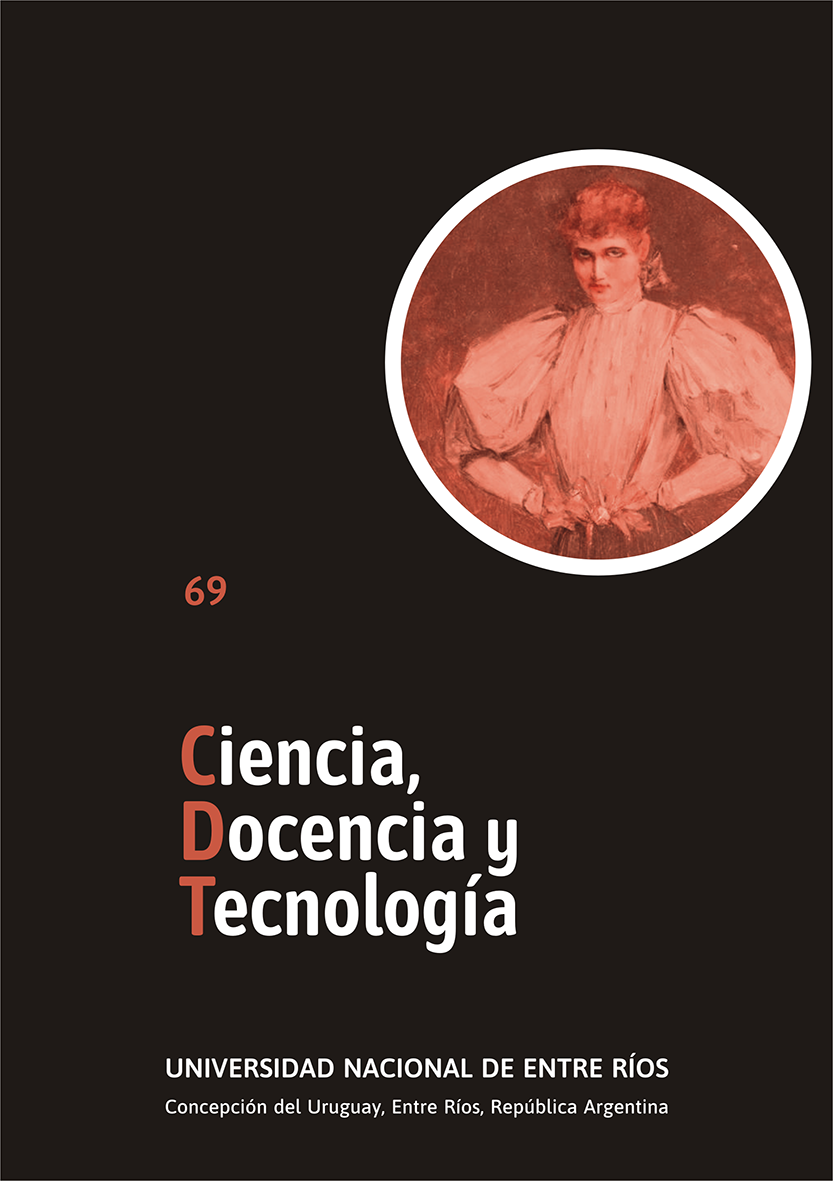¿Cómo investigar una práctica social?
Los lugares híbridos entre el laboratorio y el campo
DOI:
https://doi.org/10.33255/3469/1644Palabras clave:
ciencias de campo, ciencias de laboratorio, lugares híbridos, EGG, prácticas socialesResumen
En este artículo, nos preguntamos: ¿cómo los científicos diseñan nuevos lugares para investigar prácticas sociales? Para dar respuesta, tomamos aportes de los Estudios sobre Ciencia, Tecnología y Sociedad y la Filosofía de la Ciencia. En particular, indagamos en cómo los diversos lugares de investigación condicionan los procesos de producción de conocimientos. Focalizamos en los estudios que analizaron al campo como lugar de investigación y en cómo se articula con las prácticas de laboratorio. Si bien diversos trabajos analizaron las investigaciones en el campo en Argentina, poco problematizaron qué características específicas tiene las prácticas científicas de campo y en cómo permiten transformar prácticas sociales. A partir de tomar como fuentes primarias diversas publicaciones científicas, nuestro caso de estudio son las investigaciones neurocientíficas que utilizan electroencefalogramas (EGG) en aulas. Plantearemos que son los lugares híbridos, entre el campo y el laboratorio, los que permiten investigar prácticas sociales.
Descargas
Citas
Alimonda, H. (2011). La colonialidad de la naturaleza. Una aproximación a la ecología política latinoamericana. In H. Alimonda (Ed.), La naturaleza colonizada. Ecología política y minería en América Latina (pp. 25-44). Buenos Aires: CLACSO.
Ansell, C. K., & Bartenberger, M. (2016). Varieties of experimentalism. Ecological Economics, 130, 64-73.
Bashir, F., Ali, A., Soomro, T. A., Marouf, M., Bilal, M., & Chowdhry, B. S. (2022). Electroencephalogram (EEG) Signals for Modern Educational Research. In M. M. Asad, F. Sherwani, R. B. Hassan, & P. Churi (Eds.), Innovative Education Technologies for 21st Century Teaching and Learning (pp. 149-171). Florida: CRC Press.
Belda García, R. (2018). Diseño de un electroencefalógrafo inalámbrico, portátil y modular. (Master), Universidad Politécnica de Valencia, Valencia.
Browne, J. (1992). A science of empire: British biogeography before Darwin. Revue d'histoire des sciences, XLV(4), 453-475.
Collins, H. (1985). Changing order: Replication and induction in scientific practice. London: Sage.
Collins, H. (1988). Public experiments and displays of virtuosity: The core-set revisited. Social studies of science, 18(4), 725-748.
Dadebayev, D., Goh, W. W., & Tan, E. X. (2021). EEG-based emotion recognition: Review of commercial EEG devices and machine learning techniques. Journal of King Saud University-Computer and Information Sciences, 34(7), 4385-4401. doi:https://doi.org/10.1016/j.jksuci.2021.03.009
Dahlstrom‐Hakki, I., Asbell‐Clarke, J., & Rowe, E. (2019). Showing is knowing: The potential and challenges of using neurocognitive measures of implicit learning in the classroom. Mind, Brain, and Education, 13(1), 30-40. doi:https://doi.org/10.1111/mbe.12177
Daston, L., & Galison, P. (1992). The image of objectivity. Representations, 40, 81-128.
de Bont, R. (2017). A World Laboratory: Framing the Albert National Park. Environmental History, 22(3), 404-432. doi:https://doi.org/10.1093/envhis/emx020
Dikker, S., Wan, L., Davidesco, I., Kaggen, L., Oostrik, M., McClintock, J., . . . Ding, M. (2017). Brain-to-brain synchrony tracks real-world dynamic group interactions in the classroom. Current Biology, 27(9), 1375-1380. doi:https://doi.org/10.1016/j.cub.2017.04.002
Fontanillo López, C. A., Li, G., & Zhang, D. (2020). Beyond Technologies of Electroencephalography-Based Brain-Computer Interfaces: A Systematic Review From Commercial and Ethical Aspects. Frontiers in Neuroscience, 14, 611130. doi:https://doi.org/10.3389/fnins.2020.611130
Foucault, M. (2010 [1975]). Vigilar y castigar: nacimiento de la prisión (2º ed.). Buenos Aires: Siglo XXI.
García, S. V. (2014). La pesca comercial y el estudio de la fauna marina en la Argentina, 1890-1930. História, Ciências, Saúde Manguinhos, 21(3), 827-845. doi:https://doi.org/10.1590/S0104-59702014000300003
Gieryn, T. F. (2000). A space for place in sociology. Annual review of sociology(26), 463-496. doi:https://doi.org/0360-0572/00/0815-0463$14.00
Gieryn, T. F. (2006). City as truth-spot: Laboratories and field-sites in urban studies. Social studies of science, 36(1), 5-38.
Grodwohl, J.-B., Porto, F., & El-Hani, C. N. (2018). The instability of field experiments: building an experimental research tradition on the rocky seashores (1950–1985). History and philosophy of the life sciences, 40(3), 1-27. doi:https://doi.org/10.1007/s40656-018-0209-y
Gross, M., & Hoffmann-Riem, H. (2005). Ecological restoration as a real-world experiment: designing robust implementation strategies in an urban environment. Public Understanding of Science, 14(3), 269-284. doi:https://doi.org/10.1177/0963662505050791
Guggenheim, M. (2012). Laboratizing and de-laboratizing the world: changing sociological concepts for places of knowledge production. History of the Human Sciences, 25(1), 99-118. doi:https://doi.org/10.1177/0952695111422978
Hacking, I. (1992). The Self-Vindication of te Laboratory Sciences. In A. Pickering (Ed.), Science as practice and culture (pp. 85-125). Chicago: The University of Chicago Press.
Harris, D. (abr. 5, 2019). Chinese parents want students to wear dystopian brainwave-detecting headbands. The China Project. https://thechinaproject.com/2019/04/05/chinese-parents-want-students-to-wear-dystopian-brainwave-detecting-headbands/
Henke, C. R. (2000). Making a place for science: The field trial. Social studies of science, 30(4), 483-511. doi:https://doi.org/10.1177/030631200030004001
Henke, C. R., & Gieryn, T. F. (2008). Sites of Scientific Practice: The Enduring Importance of Place. In E. Hackett, O. Amsterdamska, M. Lybch, & J. Wajcman (Eds.), The handbook of science and technology studies (pp. 353-380). London: MIT Press.
Kingsland, S. E. (2009). Frits Went’s atomic age greenhouse: The changing labscape on the lab-field border. Journal of the History of Biology, 42(2), 289-324.
Klier, G., & Folguera, G. (2017). ¿Caras de una misma moneda? Conservación de la biodiversidad y extractivismo en América Latina. Letras Verdes, Revista Latinoamericana de Estudios Socioambientales, 22, 182-204.
Knorr Cetina, K. (1999). Epistemic cultures: How the sciences make knowledge. Harvard: Harvard University Press.
Ko, L.-W., Komarov, O., Hairston, W. D., Jung, T.-P., & Lin, C.-T. (2017). Sustained attention in real classroom settings: An EEG study. Frontiers in human neuroscience, 11, 388. doi:https://doi.org/10.3389/fnhum.2017.00388
Kohler, R. E. (2002a). Landscapes and labscapes: Exploring the lab-field border in biology. Chicago: University of Chicago Press.
Kohler, R. E. (2002b). Place and practice in field biology. History of Science, 40(2), 189-210. doi:https://doi.org/10.1177/0073275302040002
Kreimer, P. (2019). Science and Society in Latin America: Peripheral Modernities. London: Routledge.
Kuhn, T. (1962). The structure of scientific revolutions. Chicago: University of Chicago press.
Kuklick, H., & Kohler, R. E. (1996). Introduction. Osiris, 11(1), 1-14. doi:https://doi.org/10.1086/368752 22
Latour, B. (1983). Give Me a Laboratory and i will Raice the World. In K. D. Knorr-Cetina & M. Mulkay (Eds.), Science Observed: Perspectives on the Social Study of Science (pp. 141-170). Londres: Sage.
Latour, B., & Woolgar, S. (1979). Laboratory Life. The Construction of Scientific Facts. Beverly Hills: Sage.
Lefèvre, W. (2005). Science as labor. Perspectives on Science, 13(2), 194-225. doi:https://doi.org/10.1162/106361405774270539
Leigh Star, S. (1983). Simplification in scientific work: An example from neuroscience research. Social studies of science, 13(2), 205-228.
Livingstone, D. N. (2003). Putting science in its place. Chicago: University of Chicago Press.
Lorimer, J., & Driessen, C. (2014). Wild experiments at the Oostvaardersplassen: rethinking environmentalism in the Anthropocene. Transactions of the Institute of British Geographers, 39(2), 169-181.
Mauro, A. (2020). El programa mente-cerebro-educación. Un estudio epistemológico. Síntesis, 10, 199-220.
McCook, S. (2011). Managing monocultures: Coffee, the coffee rust, and the science of working landscapes. In J. Vetter (Ed.), Knowing global enviroments (pp. 87-108). London: Rutgers University Press.
Merlinsky, G. (2013). Cartografía del conflicto ambiental en Argentina. Buenos Aires: Fundación CICCUS.
Miller, P., & O'Leary, T. (1994). The factory as laboratory. Science in context, 7(3), 469-496. doi:https://doi.org/10.1017/S0269889700001782
Mol, A., & Law, J. (2004). Embodied action, enacted bodies: The example of hypoglycaemia. Body & society, 10(2-3), 43-62.
Pickering, A. (1992). Science as Practice and Culture. Chicago: The University of Chicago Press.
Pickering, A. (1993). The mangle of practice: Agency and emergence in the sociology of science. American journal of sociology, 99(3), 559-589.
Podgorny, I., & Lopes, M. M. (2008). El desierto en una vitrina. Museos e historia natural en la Argentina (1810-1890). D.F. México: Limusa.
Poulsen, A. T., Kamronn, S., Dmochowski, J., Parra, L. C., & Hansen, L. K. (2017). EEG in the classroom: Synchronised neural recordings during video presentation. Scientific reports, 7(1), 1-9. doi:https://doi.org/10.1038/srep43916
Rheinberger, H.-J. (1997). Toward a History of Epistemic Things: Synthesizing Proteins in the Test Tube. Stanford: Stanford University Press.
Salomon, J. J. (1997). La ciencia y la tecnología modernas. In J.-J. Salomon, F. Francisco Sagasti, & C. Sachs (Eds.), La búsqueda incierta: Ciencia, tecnología y desarrollo (pp. 8-38). D.F., México: Fondo de Cultura Económica.
Shapin, S. (1991). “The mind is its own place”: science and solitude in seventeenth-century England. Science in context, 4(1), 191-218.
Sosiuk, E. (2020). Ciencia y problemas sociales: la construcción de los pingüinos de Magallanes como especie en peligro. Ciencia, Docencia y Tecnología, 61, 71-81.
Sosiuk, E., & Martín Valdez, E. (2021). Penser des épistémologies depuis le terrain. Revue d’anthropologie des connaissances, 15(2), 55-99. doi:https://doi.org/10.4000/rac.23144
Standaert, M. (nov. 1, 2019). Chinese primary school halts trial of device that monitors pupils’ brainwaves. The Guardian. https://www.theguardian.com/world/2019/nov/01/chinese-primary-school-halts-trial-of-device-that-monitors-pupils-brainwaves
Tang, J., LeBel, A., Jain, S., & Huth, A. (2023). Semantic reconstruction of continuous language from non-invasive brain recordings. Nature Neuroscience(2), 1-9. doi:https://doi.org/10.1101/2022.09.29.509744
Thomas, H., & Santos, G. (2016). Tecnologías para incluir: ocho análisis socio-técnicos orientados al diseño estratégico de artefactos y normativas. Carapachay: Lenguaje claro Editora.
Värbu, K., Muhammad, N., & Muhammad, Y. (2022). Past, Present, and Future of EEG-Based BCI Applications. Sensors, 22(9), 3331. doi:https://doi.org/10.3390/s22093331
Wang, Y., Hong, S., & Tai, C. (oct. 24, 2019). China’s Efforts to Lead the Way in AI Start in Its Classrooms. The Wall Street Journal. https://www.wsj.com/articles/chinas-efforts-to-lead-the-way-in-ai-start-in-its-classrooms-11571958181
Williamson, B. (2018). Brain data: Scanning, scraping and sculpting the plastic learning brain through neurotechnology. Postdigital Science and Education, 1(1), 65-86. doi:https://doi.org/10.3389/fnins.2016.00530
Williamson, B. (2021). Digital policy sociology: Software and science in data-intensive precision education. Critical Studies in Education, 62(3), 354-370. doi:https://doi.org/10.1080/17508487.2019.1691030
Xu, J., & Zhong, B. (2018). Review on portable EEG technology in educational research. Computers in Human Behavior, 81, 340-349. doi:https://doi.org/10.1016/j.chb.2017.12.037
Publicado
Cómo citar
Número
Sección
Licencia
Derechos de autor 2023 Ezequiel Sosiuk, Agustín Mauro

Esta obra está bajo una licencia internacional Creative Commons Atribución-NoComercial-CompartirIgual 4.0.
Los autores conservan los derechos de autor y garantizan a la revista el derecho de ser la primera publicación del trabajo, al igual que licenciarlo bajo una Creative Commons Attribution License que permite a otros compartir el trabajo con un reconocimiento de la autoría del trabajo y la publicación inicial en esta revista. Todo el contenido es publicado bajo licencia internacional Creative Commons 4.0: Atribución-No Comercial-Compartir Igual.






